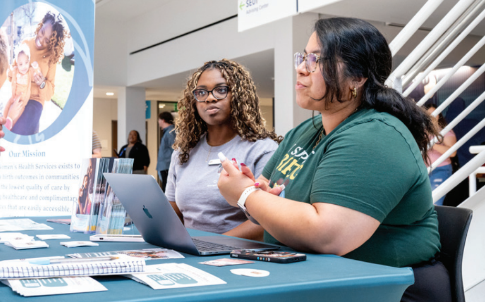Media alters perception of glamour
By Abraham Haifa/reporter
A speaker challenged an audience March 26 to think about society’s standards of what is considered beautiful for women and why.
SE history instructor Stephanie Hawkins presented “All American Girl: The Politics of Race, Gender, Culture in the Miss America Pageant” on SE Campus as a part of Women’s History Month.
“What is Miss America, [and what does she look like]?” Hawkins asked.
She referred to an ad campaign by makeup company Almay that featured the tagline “discover the American look” with Kelly Clarkson on the cover and asked the audience “What does that even mean?”
Hawkins said these perceptions of what an “all-American girl” is supposed to be is a false narrative.
Literature geared towards young girls by using Disney princesses is an example of how the media can alter the public’s perception of what beauty is supposed to look like, such as small waists, big beautiful eyes and large breasts, she said.
“The prettiest one always wins,” Hawkins said. “If you’re a good person you’re beautiful. If you’re a bad person, you’re going to be ugly.”
This is how fairy tales usually display characters in Disney movies, which kids are watching and could lead them to think this sort of thing is true, she said.
“Disney, just like U.S. pageants, represent American society a lot,” Hawkins said. “Watching movies like ‘Cinderella’ or ‘Snow White,’ you’re able to track how America is viewing race or viewing women.”
She discussed issues with race, specifically in Hollywood, and how it is harder for women of color to be successful.
“Ethnic women, specifically black women and people of color, have to deal with discrimination,” Hawkins said. “If you’re racially ambiguous and you’ve decided to pass as white, you’re fine.”
She displayed images of Rita Hayworth, an actress in the 1940s, as an example. Hayworth, whose real name was Margarita Carmen Cansino, had to change her image to fit what society deemed an “all-American girl.”
“She was of black descent, but they thought she looked too ethnic,” Hawkins said. “They made her go under painful lasering. They brought up her hairline because they felt she looked too ethnic and bleached her hair and dyed it red.”
The discrimination during that time period made it harder to get movie roles if you were ethnic, she said.
“I knew a little bit about pageants, but I never thought about the culture aspect of it,” SE Campus history instructor Scott Maloney said.
Hawkins also discussed the 1968 movement, where black women protested the Miss America beauty pageant for not being racially inclusive. These protests lead to the crowning of a Miss Black America.
“A gentleman, who is the organizer of Miss Black America, asked his daughters ‘What do you want to be when you grow up?’ and they said I want to be Miss America,” Hawkins said.
Being African-American, he knew his daughters probably weren’t going to be allowed in, so he created Miss Black America, she said.
“Pageants were a way for women to compete, without having to compete with men,” said Zena Jackson, SE Campus vice president of academic affairs.
































